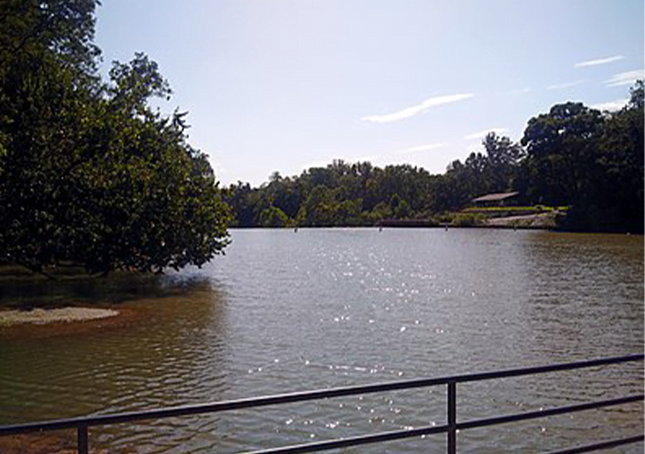Lake Roland (Maryland)

Lake Roland is a 100-acre (0.40 km2) defunct reservoir in Baltimore County, Maryland. It was named for Roland Run, a nearby stream that feeds the lake and eventually flows into Jones Falls. It runs southeast through the city center to the Northwest Branch of the Patapsco River and the Baltimore Harbor.[1][2][3][4][5][6][7] It is located just north of the Baltimore city limits.
The lake is contained within the bounds of Lake Roland Park, which was established in the 1920s and supervised by the newly organized Baltimore City Department of Parks and Recreation.[8][9] The lake is an artificial impoundment created by a dam on Jones Falls and two smaller streams: Towson Run and Roland Run. The lake supports wildlife including Canada geese, largemouth bass, and common carp. The lake is part of the Lake Roland Historic District.
The lake was once called Lake Swann to honor Mayor Thomas Swann of Baltimore City, who had begun the construction of the dam at the relay house on the Northern Central Railroad.[10] The name Roland comes from Roland Run, which was named sometime before 1694 when Roland or Rowland Thornberry owned a land tract in the area.
In 1854, the City of Baltimore bought the entire holdings of the privately owned Baltimore Water Company, which had supplied water to the city for fifty years, followed between 1854 and 1857 by acquisition of the land held by the Bellona Gunpowder Mill and the Eagle Factory, a textile mill, for $289,000.[10][11][12] This purchase followed a political controversy regarding the failure of the water company to extend new water lines into surrounding outlying areas of the city. The city had added territory in its last annexation in 1818.[13] The Bellona Gunpowder Mill, which had operated from at least 1801 on the west side of the lake, and the Eagle Factory, which had operated there since at least 1814, were displaced by the land purchase, while the Baltimore & Susquehana Railroad stayed in place. The railroad was later destroyed by pro-Confederate forces during the American Civil War and reconstructed by pro-Union forces as they advanced southward.
Engineer James Slade, from Hartford, Connecticut, who improved the existing network based on “old Jones Falls mill ponds”, and had a detailed plan in place, and construction supervisor Charles P. Manning, began construction in 1858, with the creation of an “indestructible” dam made out of “heavy rubble work”.[10][14] In 1861, Lake Roland became the first municipal water supply for the City of Baltimore; it was seen as an “engineering landmark” at the time.
The dam and Greek Revival-style pump building on the eastern shore of the lake were constructed the following year. While plans to tap the Gunpowder River stopped with new reservoirs in the city and stopgap measures at Lake Roland, by 1877, Lake Roland was fed by the river, with the idea for this change likely coming from Slade rather than Henry Tyson, another engineer; a pipe served as a conduit of water between Lake Roland and Hampton Reservoir, among other bodies of water.
Lack of water was not the only problem the lake experienced. At times, the water was “clouded or turbid from rain-borne particles” as dredging was attempted to make the reservoir deeper. Increased mud and silt closed the lake for hundreds of days by 1912, accompanied by costs in the thousands of dollars for upkeep.
One Baltimore County newspaper in 1877 even described the lake as a “receptacle of filth” from nearby industry, including the railroad junction of the Northern Central Railroad and Green Spring Railway, and declaring that “Towsontowners never drink any water when they get into the city”, even as others admired the lake as a “charming scene.”
